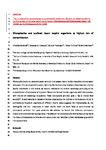Microplastics and seafood: lower trophic organisms at highest risk of contamination
| dc.contributor.author | Walkinshaw, C | |
| dc.contributor.author | Lindeque, PK | |
| dc.contributor.author | Thompson, R | |
| dc.contributor.author | Tolhurst, T | |
| dc.contributor.author | Cole, M | |
| dc.date.accessioned | 2021-08-18T22:19:42Z | |
| dc.date.issued | 2020-03-01 | |
| dc.identifier.issn | 0147-6513 | |
| dc.identifier.issn | 1090-2414 | |
| dc.identifier.other | 110066 | |
| dc.identifier.uri | http://hdl.handle.net/10026.1/17612 | |
| dc.description.abstract |
Microplastic debris is a prevalent global pollutant that poses a risk to marine organisms and ecological processes. It is also suspected to pose a risk to marine food security; however, these risks are currently poorly understood. In this review, we seek to understand the current knowledge pertaining to the contamination of commercially important fished and farmed marine organisms with microplastics, with the aim of answering the question "Does microplastic pollution pose a risk to marine food security?". A semi-systematic review of studies investigating the number of microplastics found in commercially important organisms of different trophic levels suggests that microplastics do not biomagnify, and that organisms at lower trophic levels are more likely to contaminated by microplastic pollution than apex predators. We address the factors that influence microplastic consumption and retention by organisms. This research has implications for food safety and highlights the risks of microplastics to fisheries and aquaculture, and identifies current knowledge gaps within this research field. | |
| dc.format.extent | 110066-110066 | |
| dc.format.medium | Print-Electronic | |
| dc.language | en | |
| dc.language.iso | en | |
| dc.publisher | Elsevier | |
| dc.subject | Plastic | |
| dc.subject | Food security | |
| dc.subject | Aquaculture | |
| dc.subject | Trophic transfer | |
| dc.subject | Biomagnification | |
| dc.title | Microplastics and seafood: lower trophic organisms at highest risk of contamination | |
| dc.type | journal-article | |
| dc.type | Article | |
| plymouth.author-url | https://www.ncbi.nlm.nih.gov/pubmed/31846861 | |
| plymouth.volume | 190 | |
| plymouth.publication-status | Published | |
| plymouth.journal | Ecotoxicology and Environmental Safety | |
| dc.identifier.doi | 10.1016/j.ecoenv.2019.110066 | |
| plymouth.organisational-group | /Plymouth | |
| plymouth.organisational-group | /Plymouth/Faculty of Science and Engineering | |
| plymouth.organisational-group | /Plymouth/Faculty of Science and Engineering/School of Biological and Marine Sciences | |
| plymouth.organisational-group | /Plymouth/REF 2021 Researchers by UoA | |
| plymouth.organisational-group | /Plymouth/REF 2021 Researchers by UoA/UoA07 Earth Systems and Environmental Sciences | |
| plymouth.organisational-group | /Plymouth/Research Groups | |
| plymouth.organisational-group | /Plymouth/Research Groups/Marine Institute | |
| plymouth.organisational-group | /Plymouth/Users by role | |
| plymouth.organisational-group | /Plymouth/Users by role/Academics | |
| plymouth.organisational-group | /Plymouth/Users by role/Researchers in ResearchFish submission | |
| dc.publisher.place | Netherlands | |
| dcterms.dateAccepted | 2019-12-06 | |
| dc.rights.embargodate | 2021-8-25 | |
| dc.identifier.eissn | 1090-2414 | |
| dc.rights.embargoperiod | Not known | |
| rioxxterms.versionofrecord | 10.1016/j.ecoenv.2019.110066 | |
| rioxxterms.licenseref.uri | http://www.rioxx.net/licenses/all-rights-reserved | |
| rioxxterms.licenseref.startdate | 2020-03-01 | |
| rioxxterms.type | Journal Article/Review |


